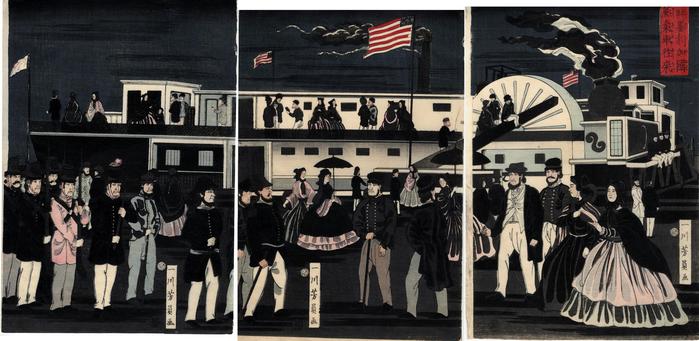Utagawa Yoshikazu (歌川芳員) (artist )
Transit of an American Steam Locomotive (Amerika koku jōkisha ōrai - 亜墨利加国蒸気者往来)
10/1861
28 in x 14 in (Overall dimensions) Japanese color woodblock print
Signed: Issen Yoshikazu ga
一川芳員画
Publisher: Moriya Jinpachi (Marks 294 - seal 08-088)
Combined censor-date seal: 10/1861 and aratame
Museum of Fine Arts, Boston
Metropolitan Museum of Art
Harvard Art Museums
Art Institute of Chicago
Library of Congress
The National Museum of Asian Art
Royal Museums of Art and History, Belgium (via Cultural Japan) - right-hand panel only
Art Gallery of Greater Victoria - right panel only
Náprstek Museum
Kobe City Museum
Princeton University Art Museum "The popular image the Japanese held of the United states in the early 1860s was that of a powerful and technologically advanced nation. The first Japanese embassy to the United States in 1860 provided a group of well-educated and promising young men with a firsthand experience in the young Western country. Wood engravings for newspaper illustrations of that embassy to America provided Japanese artists with models for the costumes and customs of Americans. Figures based on those illustrations were repeated in later prints of foreign subjects. The figures in the foreground of this print are also drawn from illustrations of Americans from western periodicals. The dominant image in the background purports to represent a steam locomotive, but its scale and some of its details, such as the large wheel on the right, make it clear that the artist has depicted instead a paddle-wheel steamboat. The print is colored almost entirely in black and grey, shades that impart a nocturnal ambience."
Quoted from: Yokohama, Prints from Nineteenth-century Japan, cat. #66, page 162.
See also: Yokohama Prefectural Museum Catalogue, page 135.
****
Illustrated:
1) Ukiyoe Museums in Japan (Nihon no ukiyoe bijutsukan - 日本の浮世絵美術館), vol. 4, p. 64. This example is from the collection of the Transportation Museum (交通博物館). They date their copy to 1853. It is printed mainly in browns and rose colors.
2) in color in International Exchange Exhibition: Japan and the West in Japanese Prints, Kanagawa Prefecture International Exchange Executive Committee, Walters Art Gallery, Baltimore, 1982, p. 63, #250.
3) in color in Japanese Prints: Images of the Floating World, Barry Davies Oriental Art, #188, illustrated on p. 199.
4) in color in Catalogue of Japanese Art in the Náprstek Museum published by The International Research Center for Japanese Studies: Nichibunken Japanese Studies Series 4, 1994, p. 173.
5) in color in Yokohama, Prints from Nineteenth-century Japan by Ann Yonemura, Smithsonian Institution, 1990, cat. #66, page 162.
6) in color in Japanese Woodblock Prints: Artists, Publishers and Masterworks 1680-1900 by Andreas Marks, Tuttle Publishing, 2010, pages 200-201.
****
There is another copy of this triptych in the Modern Transportation Museum in Japan.
****
Note the three stylized American flags flying above the steamboat. There aren't a lot of Japanese prints showing the 'Stars and Stripes'. Other artists who displayed this oddity were Sadahide, Hiroshige III and Yoshitora. However, Yoshikazu was not always as terribly accurate as he was here in his rendition. All he ever seemed to want was the essence of the design and did little to nothing to recreate the flag precisely. One of his triptychs in the collection of the Met shows four broad reds bars and four white bars. Nothing like the 7 red stripes and 6 white ones we see today.
On June 14, 1777 the Continental Congress resolved that the flag should have thirteen stripes, one for each state in the new Union. Yoshikazu and his peers could not have known this, nor could they have cared. So, like almost all designers they took artistic license with their subject. The rarity of this symbol in Japanese prints makes this triptych all the more special in our eyes. (JSV)
****
Roger Keyes in his 1982 doctoral dissertation on Yoshitoshi wrote briefly about the craze for images of foreigners in 1860-61. "To satisfy public curiosity, the Edo print publishers commissioned well-known artists of the ukiyo-e school to visit Yokohama and make drawings of things that particularly interested them, and in 1860 and 1861 hundreds of woodblock prints of foreigners were published."
Maruya Jinpachi (丸屋甚八) (publisher)
Historical - Social - Ephemera (genre)
